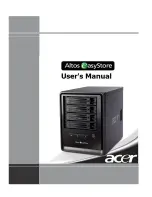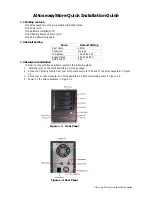
Understanding the PowerVault 35F Configuration: Dell PowerVault 35F User's Guide
file:///C|/Users/rishi_sood/Desktop/35F/ug/config_1.htm[3/21/2013 11:16:19 AM]
SCSI
Fibre Channel
The Indexed Addressing table has the structure shown in
Table 1
. The PowerVault 35F will allow up to 80 device
entries to be mapped. The index table can be manually edited, and is then saved to FLASH memory. A configuration
menu allows for the table to be filled in order of increasing target, or LUN, as may be desired for the specific
requirements needed. An assist is also provided to perform device discovery, and fill the table in the order that devices
are discovered on a SCSI bus.
Indexed Addressing mode is recommended for environments where device configuration may change, and a fixed
mapping from the application to the target devices is required. An example of such an environment is where hot plug
devices may be used, thereby changing the order of devices on a SCSI bus.
Auto Addressing
The Auto Addressing option is similar to Indexed Addressing, but with the distinction that the table used is created
through SCSI device discovery upon power up or reset, and not otherwise retained. As the unit performs device
discovery on a SCSI bus, the Index table is filled with adjacent FCP LUNs referencing each subsequent SCSI device.
The host system will then detect every attached device without voids, allowing full device discovery to the host. This
allows easy configuration in environments where device ordering is not important, and hot plugging of SCSI devices
will not occur. Configuration allows for discovery to be performed in order of target or LUN, as desired for the
specific environment.
Auto Addressing, target mode is configured as the default mode of thePowerVault 35F.
SCC Addressing
The PowerVault 35F implements the SCSI-3 Controller Commands (SCC) (X3T10 Project 1047D Revision 6b 01-
July-96) ) SCSI storage array addressing to address SCSI devices attached to the PowerVault 35F. The Access Method
used is the SCC Logical Unit Addressing method.
In SCC Addressing mode, the PowerVault 35F will respond to FCP commands, as in a SCC controller device. A
subset of the SCC behavior is implemented. LUN mappings corresponding to the SCC Peripheral Device Addressing
are interpreted as controller commands, and are acted on by the PowerVault 35F directly. LUN mappings using SCC
Logical Unit addressing are routed to the appropriate SCSI BUS:TARGET:LUN and processed accordingly.
The SCC mode requires support from the HBA and device drivers for proper operation. Further description of the
PowerVault 35F implementation of SCC addressing is in
Addressing, Structures and Operation
.
SCSI Host to Fibre Channel Target Configuration
This section describes the configuration of the PowerVault 35F when acting as a target to a SCSI Initiator, passing
requests through to Fibre Channel targets.
SCSI-to-Fibre Channel mapping is implemented in a fashion similar to Fibre Channel-to-SCSI Indexed Addressing
mode. The PowerVault 35F responds to commands issued to a set of configured SCSI IDs, and maps these to Fibre
Channel AL_PA/LUN values. The following table indicates a possible mapping for SCSI LUN to Fibre Channel
AL_PA:LUN.
Table 2. SCSI-to-Fibre Target:Channel Address Mapping
















































